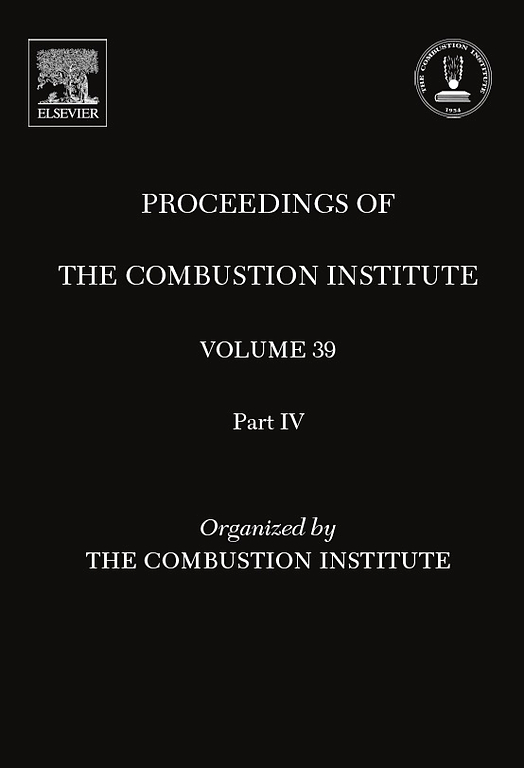Numerical simulations of TiO[formula omitted] production in a laminar coflow H[formula omitted]/Ar/TTIP diffusion flame: Comparison with experiments and parametric sensitivity study
IF 5.3
2区 工程技术
Q2 ENERGY & FUELS
引用次数: 0
Abstract
Metal-oxide nanoparticles are paving the way for the development of new materials, and flame spray pyrolysis (FSP) systems are gaining attention for their large-scale production. On an industrial level, precise control of particle characteristics is needed while guaranteeing an almost zero-emission process. In this context, computational fluid dynamic (CFD) simulations of nanoparticle production in flames are sought to optimize the design of FSP systems. In this work, numerical simulations of TiO nanoparticles production from Titanium(IV) isopropoxide (TTIP) are performed for a laminar coflow H/Ar flame as a first step towards this objective. To lower the CPU cost for 2-D simulations, reduced descriptions for the gas phase and for nanoparticles are considered. For H combustion, a 10-species kinetic mechanism is retained. Five different submechanisms are tested for the description of TTIP conversion into Ti(OH), considered as the TiO precursor. The description of the solid phase relies on a classical three-equation monodisperse formulation. The objective of this work is not to validate the considered CFD strategy, for which a more extensive database would be required, but to identify the most relevant processes for flame synthesis in a diffusion flame by performing a parametric sensitivity study. The originality of this investigation relies on the study of particle characteristics along an H laminar flame in a non-premixed configuration. Thus, the focus of the parametric study is on the effect on nanoparticle characteristics of: (1) diffusion processes of gaseous phase and nanoparticles; (2) aerosol processes. Numerical results are compared to experimental data in terms of conversion rate, volume fraction, and primary particle diameter along the flame height. Trends from the literature on the effect of aerosol process parameters are retrieved. Results highlight the key role of diffusion processes on nanoparticle production in non-premixed flames and the need for future improvements of TTIP conversion kinetics.层流共流 H[式省略]/Ar/TTIP 扩散火焰中 TiO[式省略]生成的数值模拟:与实验的比较和参数敏感性研究
金属氧化物纳米粒子正在为新材料的开发铺平道路,而火焰喷射热解(FSP)系统在其大规模生产方面正受到越来越多的关注。在工业层面,需要精确控制颗粒特性,同时保证过程几乎零排放。在这种情况下,人们寻求对火焰中纳米粒子的产生进行计算流体动力学(CFD)模拟,以优化 FSP 系统的设计。作为实现这一目标的第一步,本研究对异丙醇钛(TTIP)在层流 H/Ar 共流火焰中生成 TiO 纳米粒子的过程进行了数值模拟。为了降低二维模拟的 CPU 成本,考虑减少对气相和纳米颗粒的描述。对于 H 燃烧,保留了 10 种动力学机制。在描述 TTIP 转化为 Ti(OH)(被视为 TiO 前体)时,测试了五种不同的子机制。固相的描述依赖于经典的三方程单分散公式。这项工作的目的不是验证所考虑的 CFD 策略(为此需要更广泛的数据库),而是通过进行参数敏感性研究,确定与扩散火焰中火焰合成最相关的过程。这项研究的独创性在于研究了非预混合配置下 H 层流火焰的粒子特性。因此,参数研究的重点是以下因素对纳米粒子特性的影响:(1) 气相和纳米粒子的扩散过程;(2) 气溶胶过程。数值结果与实验数据在转化率、体积分数和沿火焰高度的主颗粒直径方面进行了比较。从文献中检索了气溶胶过程参数的影响趋势。结果凸显了扩散过程对非预混火焰中纳米粒子生成的关键作用,以及未来改进 TTIP 转化动力学的必要性。
本文章由计算机程序翻译,如有差异,请以英文原文为准。
求助全文
约1分钟内获得全文
求助全文
来源期刊

Proceedings of the Combustion Institute
工程技术-工程:化工
CiteScore
7.00
自引率
0.00%
发文量
420
审稿时长
3.0 months
期刊介绍:
The Proceedings of the Combustion Institute contains forefront contributions in fundamentals and applications of combustion science. For more than 50 years, the Combustion Institute has served as the peak international society for dissemination of scientific and technical research in the combustion field. In addition to author submissions, the Proceedings of the Combustion Institute includes the Institute''s prestigious invited strategic and topical reviews that represent indispensable resources for emergent research in the field. All papers are subjected to rigorous peer review.
Research papers and invited topical reviews; Reaction Kinetics; Soot, PAH, and other large molecules; Diagnostics; Laminar Flames; Turbulent Flames; Heterogeneous Combustion; Spray and Droplet Combustion; Detonations, Explosions & Supersonic Combustion; Fire Research; Stationary Combustion Systems; IC Engine and Gas Turbine Combustion; New Technology Concepts
The electronic version of Proceedings of the Combustion Institute contains supplemental material such as reaction mechanisms, illustrating movies, and other data.
 求助内容:
求助内容: 应助结果提醒方式:
应助结果提醒方式:


